Fishing lingo is a language all its own, so we put together this glossary of fishing terms to make sure everyone’s on the same page as they talk about Chesapeake Bay fishing and angling in our nearby waters. Whether you enjoy kayak fishing in a quiet pond, heading offshore to hunt for pelagics, or anything in between, let’s get linguistic.
A - B - C - D - E - F - G - H - I - J - K - L - M - N - O - P - Q - R - S - T - U - V - W - X - Y - Z
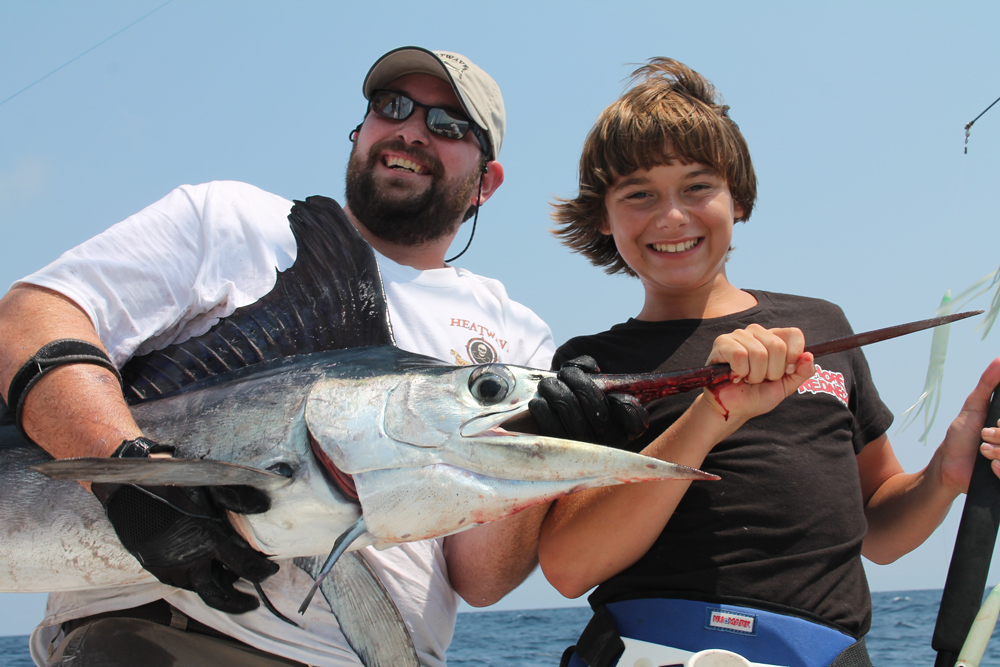
A
Angler – We sincerely hope you already know this one: it’s people who fish. If you’re reading this right now, chances are you’re an angler, too.
Artificials – A general term used to apply to any man-made lure used to catch fish, as opposed to using bait.
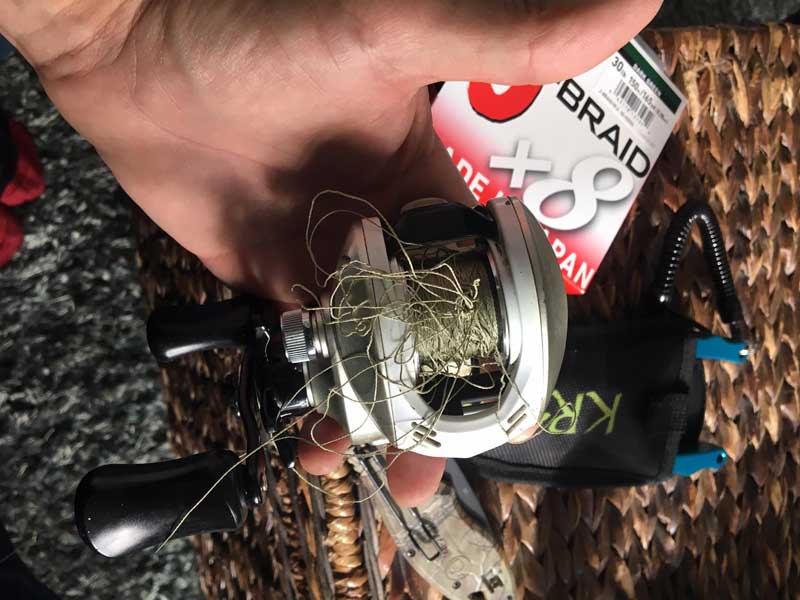
B
Backlash – When casting or letting out line under tension, the revolving spools on many types of conventional reels can begin to spin faster than the line comes off. This results in a tangle known as backlash, or a “bird’s nest.”
Back-cast – The act of swinging a rod backwards, behind the angler, prior to casting forward, to increase the rod’s range of motion.
Baitcaster – This is a type of conventional reel used for many types of fishing, which has a revolving spool. The main difference between this and a spinning reel is that the line on a spinning reel is taken up with a revolving “bail,” as opposed to being reeled up on the spool itself. Baitcasters often provide better accuracy than spinning reels since the speed they revolve at can be controlled with thumb pressure, but backlash (see above) can be a problem, especially with inexperienced anglers.
Bail (Bailor) – The ring of metal which rotates around the fixed spool of a spinning reel, to bring inline. In order to cast a spinning reel, the bail flips open.
Bailling – A fishing technique similar to chunking or chumming but practiced while adrift, tossing bait chunks into the water along with a baited hook, to trigger a feeding frenzy. Some people also use the term to describe a situation when fish feeding so rapidly it’s possible to hook and swing multiple fish into the boat in a matter of minutes.
Barb – The protruding part of the hook near its point, which prevents it from backing out of and falling from a fish’s mouth.
Barbless Hook – A hook with no barb, commonly used for catch and release fishing.
Bird’s Nest – See backlash.
Bait – Any item placed on a hook with the intent of tricking fish into eating it.
Bladebait – A type of lure consisting of a large, blade-like piece of metal which vibrates or appears to swim in the water.
Blind Cast – A tactic used for prospecting, often in unfamiliar water, where the angler simply casts in different directions.
Bobber – A small float used to suspend a bait or lure at a specific depth. Many people use the term “float” interchangeably.
Bottom Fishing – The tactic of dropping a bait to the bottom, usually while either at anchor or adrift.
Bottom Bouncing – A type of trolling where the rod is jigged as the boat moves forward, to bounce the sinker off the bottom, thus keeping the lure very close to the bottom.
Braid – A popular type of fishing line which is made of Dyneema, has very little stretch, low diameter, and excellent sensitivity. The other main type is monofilament. The differences between lines are examined in The Best Fishing Line: Monofilament Versus Braid.
Breaking – A term used to describe schooled fish that are in a visible feeding frenzy on the surface, often indicated by diving birds which are feeding on injured baitfish. Tactics used for catching fish in this situation are described in Keepers in the Chaos: How to Catch Big Fish Under Working Birds.
Breaking Strength – Every fishing line has a point at which it breaks, which is its breaking strength. This is commonly measured in pounds, and expressed as the “pound test” of the line.
Bucktail – One of the oldest yet most versatile types of lures around, bucktails are made by tying deer hair to a lead head.
Bunker – A very common type of baitfish. Bunker are also known as menhaden, pogeys, fatback, and alewives.
Buzzbait – Buzzbaits are lures with propeller-like spinners designed to churn the water (buzzing across the surface) as they are retrieved.
C
Cast – The act of swinging a fishing rod and releasing the line, to propel a bait or lure through the air.
Centrifugal Brake – The braking system employed by many baitcasting reels to reduce backlash.
Chatterbait – A type of lure combining a lead-head jig with a metal blade. White retrieved the blade creates a “chatter” by swinging back and forth and tapping against the jig head.
Chum (Chumming) – The tactic of putting ground fish or other bait into the water to attract predators to your boat or location. See Chumming Tricks to learn more about this method of fishing.
Chunk (Chunking) – Similar to chumming, chunking also disburses bait into the water but in a chopped form, instead of ground. See How to Chunk For Tuna to learn more about this method.
Circle Hook – A hook with a circular shape, intended to hook a fish in the corner of the jaw.
Citation – Many organizations and governments award unusual or trophy-sized catches by issuing an angler a citation, similar to a certificate of merit.
Conventional Reel – Like baitcasters, conventional reels have a revolving spool. To some degree the terms are used interchangeably, but generally speaking conventionals are not intended for casting and tend to be larger and heavier, designed for trolling or other forms of fishing.
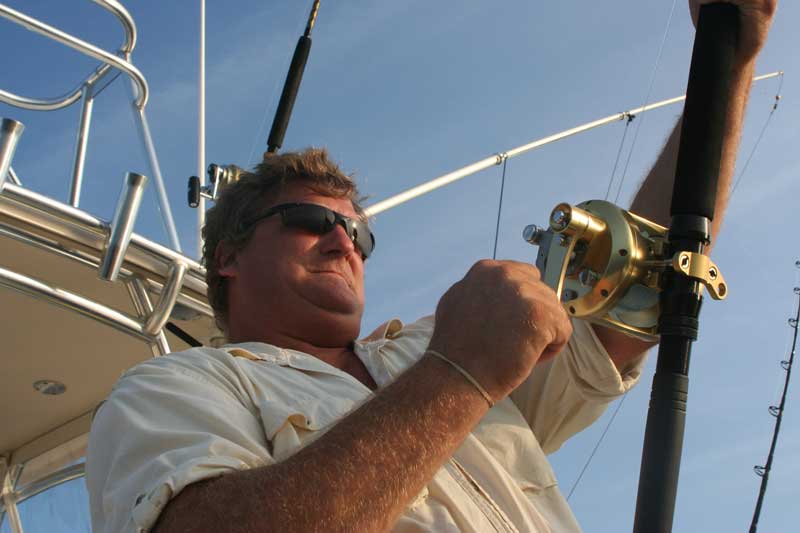
Crankbait – A lure that has a swimming action of its own as it’s retrieved (via cranking the reel) through the water.
Creel Limit – The maximum number of fish an angler is allowed to keep, by law.
Crimp – A small piece of metal squeezed down on fishing line to keep it in place.
D
Dead-stick – A method of fishing where the bait or lure is lowered to a certain depth, and the rod is held steady until a fish strikes.
Deceiver (Lefty’s Deceiver) – A classic type of fly fishing lure developed by the legendary fly fisherman Lefty Kreh.
De-hooker – A tool used to quickly and easily remove the hook from a fish’s mouth.
Deep Dropping - Any method of fishing when the bait or lure (usually bait) is dropped hundreds of feet down in the ocean.
Drag – The part of a reel that allows fish to pull out line, when it applies enough pressure to possibly break the line. Most drags consist of a combination of pads and washers between the spool and the reel’s frame or pinion.
Dredge – An extremely large teaser usually consisting of a wire frame and dozens (or more) of lures, used to simulate a school of baitfish following a boat. Dredges are most commonly used while trolling offshore, to attract marlin.
Drift Fishing – The tactic of allowing your boat to drift while you’re fishing.
Downrigger – A heavy-duty reel and boom used to deploy weights far too heavy for fishing rods. Commonly, fishing lines are then attached to release clips on the downrigger line, and lowered to the desired depth.
Drop-Shot – A rigging technique where the weight is located below the lure, usually a plastic worm.
Dry Fly – A lure used for fly fishing which is intended to float on top of the water, thus remaining dry.
F
Fang Hook – Two hooks welded or bent together, to create a single unit.
Feathering – The practices of placing your hand in the way of line spilling from the reel during a cast, to slow the cast down or cause it to drop short.
Flipping – A casting technique used for short distances, where the lure is pendulumed from the raised rod tip and flipped to the target.
Float – Another word for bobber.
Flourocarbon – A type of monofilament fishing line which is less visible underwater then more common, less expensive monofilament.
Fly Fishing – A type of fishing in which the weight of the line, not the lure, is used to cast.
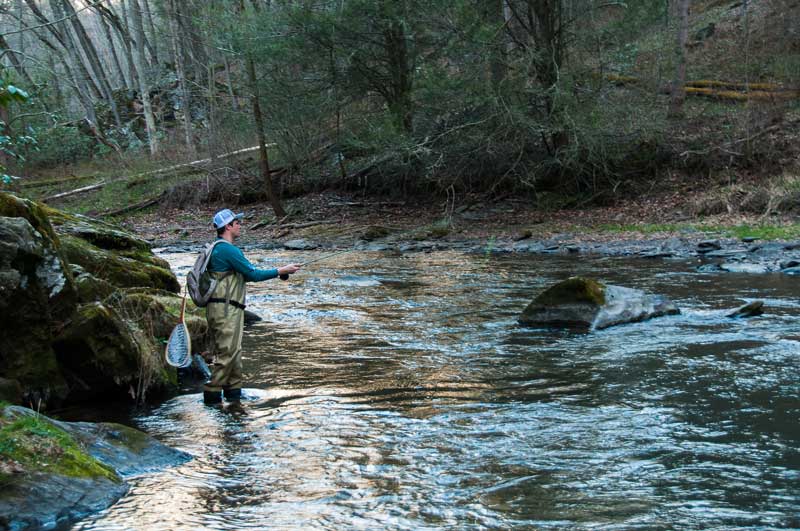
Freespool – Disengaging a reel and allowing the spool to spin freely.
Foul Hook – A term applied to a fish that is snagged by a hook anywhere except in the mouth.
G
Gaff (Flying Gaff) – A large hook mounted on a pole, used to haul large fish over the side of the boat. In the case of a flying gaff, the hook is detachable from the pole and is tied to a stout rope which can be cleated off to the boat. Flying gaffs are usually reserved for fish so large that they would otherwise yank the gaff out of a person’s hands. Our video How to Gaff a Tuna: Proper Techniques and Tactics describes how it's used.
Gear Ratio – Fishing reels have gears, like cars or winches, which allows them to bring in line at faster speeds. If a reel has a gear ratio of 4:1, for example, every time you turn the crank the spool (or bail) will revolve four times.
Hard Bait – A lure made of metal, plastic, or other hard materials.
Hook-set – Jerking the rod tip back vigorously when a fish bites, to set the hook firmly into its mouth or jaw. How to Set the Hook on a Fish describes how it's done in detail.
Ice Auger – A large drill used to make holes in the ice for ice fishing.
I
Ice Fishing – the practice of cutting or drilling holes through the ice on a frozen river, lake, or bay, and fishing through it. Also see “insane” (but we love it, too!)
Inshore – A term with variable meanings relevant to the area; some anglers would call fishing in protected waters “inshore,” while some others would term anything inside of the Continental Shelf as “inshore” waters.
J
Jerkbait – A lipped plug similar to a crankbait, which has neutral buoyancy and is designed to be used with a stop-and-go retrieve, with occasional jerks during the pauses.
Jig – The term jig is used to describe a number of different types of lures. As a verb, jig is used to describe the action of jerking a rod tip to impart a life-like motion to a bait or lure (see jigging).
Jigging – The act of constantly moving the rod tip to impart motion to a lure or bait. There are many different types of jigging and this is an extremely popular way of fishing; some common techniques are:
- Cast-and-retrieve jigging (also commonly called “light tackle jigging”) where a lure is cast out then jigged during the retrieve.
- Meat jigging, the practice of adding natural bait to a jig and hovering it at a particular depth.
- Speed jigging, where the lure is reeled up as fast as possible and jigged simultaneously.
- Vertical jigging, which is lowering the lure or bait to a specific depth, then causing it to jump up and down vertically.
- Yo-Yoing, a technique where the lure is dropped then reeled straight up repeatedly.
For a complete run-down on different types of jigging see Rudow's Guide to Modern Jigging. Some of our specific how-to articles relating to jigging include:
- Jigging for Dog Day Stripers
- Late Fall/Early Winter Light Tackle Striper Jigging on the Chesapeake
- Jigging the Chesapeake Bay Bridge Pilings
- How to Rig Metal Jigging Spoons
- Jigging for Fall Redfish
- Speed Jigger's Primer
K
Kayak Fishing - The practice of fishing from a kayak. This has become incredibly popular in recent years.
Kite Fishing – Using a kite to suspend a fishing line out and away from a boat.
L
Landing Net - A net used to bring a hooked fish into a boat or up onto the shoreline. See our video How to Choose a Landing Net for Boat Anglers to learn about a net's different aspects.
Leader – A length of line, usually heavier than the main line, used to connect the lure or hook to the main line. Leaders are often added because the end of the line may get abraded by a fish’s teeth or structure the fish are holding close to. In some cases leaders are also added to reduce visibility. And in other cases wire leaders may be added to prevent bite-offs from toothy fish.
Lead-head – A piece of lead molded to a hook, which is then dressed with a soft plastic, skirt, teaser, or other additional lure. On occasion, lead-heads may also be used with bait.
Level Winder – A conventional reel that has a guide attached to a worm gear, which moves the guide back and forth as the reel is cranked. This lays the line evenly from side to side on the spool to prevent it from bunching up.
Lever Drag – A drag system which can be adjusted with a lever, usually placed where it can be manipulated with the right thumb. Lever drags are most common on big-game conventional reels and tend to be more expensive than other options, but are the ultimate for making exact adjustments to drag tension during a battle.
Lipless Crankbait – Crankbaits without a plastic lip, designed so water resistance causes them to swim in a lifelike manner. The Rat-L-Trap is considered the classic crankbait.
Lipping – Grabbing a fish by inserting your thumb in its mouth and pinching down on the lower jaw, or lip. While an effective way of holding and controlling fish with dull teeth, it’s an extremely painful way to hold fish with sharp teeth.
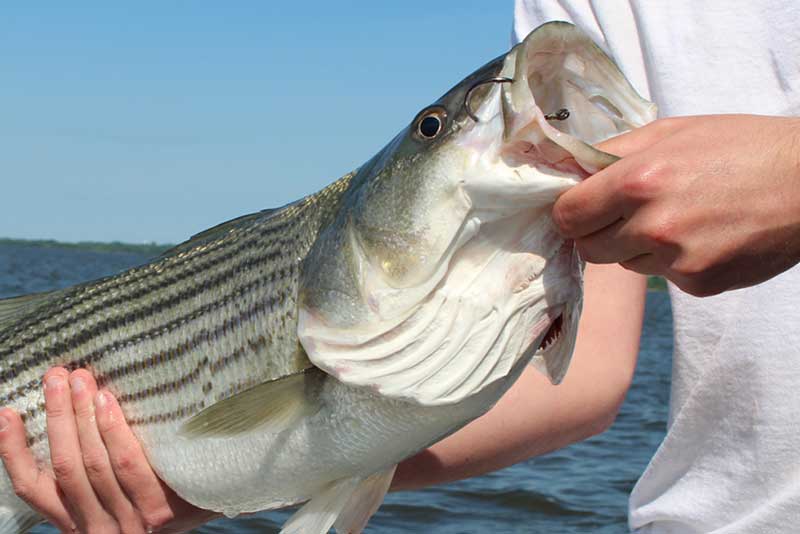
Live-lining (Live-baiting) – The technique of using live baitfish on a hook as bait, either with or without weight and additional terminal tackle.
Livewell (Baitwell) – A compartment in a boat designed to hold live baitfish. Most have some form of water circulation or aeration.
Lunker – A very, very big fish.
Lure – An artificial bait.
M
Monofilament – A common type of fishing line made of nylon, which is high-stretch and has high abrasion resistance.
O
Offshore – A term with variable meanings relevant to the area; some anglers would call fishing anywhere in the ocean “offshore,” while some others would only consider waters beyond the edge of the Continental Shelf as being truly offshore.
Outriggers – Poles used on large sportfishing boats to hold fishing lines off to the sides of the boat.
P
Paddle-tail – A type of soft plastic lure which has a paddle-shaped tail that wiggles back and forth when retrieved through the water.
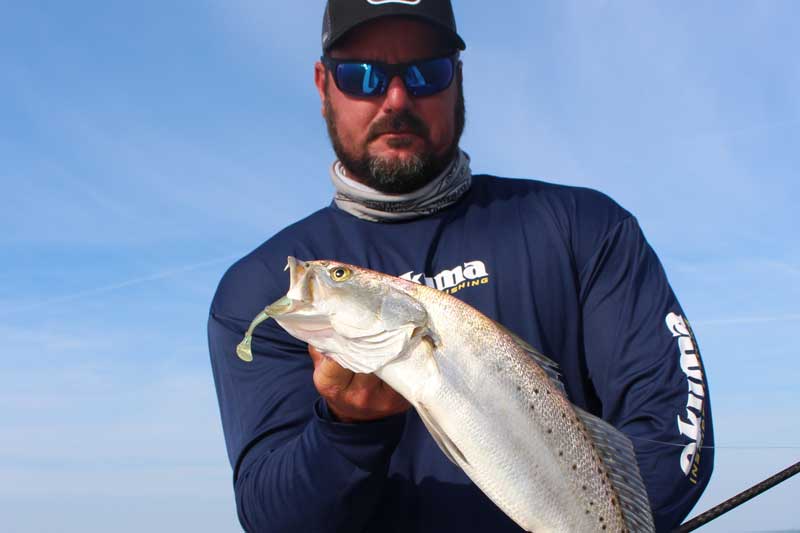
Pelagic – A free-swimming oceanic fish, such as tuna, billfish, and mahi-mahi.
Plug (Swimming Plug) – A hard plastic or wood artificial lure that is usually cast and retrieved or sometimes trolled.
Pole - Many people use the term "pole" to describe fishing rods in general, but this is inaccurate. Fishing poles do not have reels or guides, but are the simplest form or rod, with a length of line tied off to the end. Though rudimentary, fishing with a pole can still be very effective, as described in Fishing With a Pole and Line: Back to Basics.
Poor Man’s Downrigger – Slang for using a diving planer or a heavy weight, usually tied off to the boat, in leu of a downrigger.
Pound-test – The rated strength at which a fishing line breaks. Ten pound-test is supposed to break only when 10 pounds of pressure or more is applied.
Pounding - A tactic used to make a jig or lure quiver enticingly, underwater.
Propbait – A plug or lure with small propellers that spin when the lure is retrieved.
R
Rod – We think this one’s pretty self-explanatory. But we do understand that the different aspects, pieces, and parts of a rod can cause some confusion, so:
- Action – This term describes the physical property of the rod; a fast action rod bends mostly at the tip and quickly becomes rigid as you move down the rod; conversely, a slow action rod bends from the tip all the way to the butt.
- Butt – The very end of the rod. There are smooth rod butts, and gimbaled rod butts. When gimbaled (usually for use with big-game pelagics), they have notches built in which grip a fighting belt. Some trolling rods also have gimbaled butts to ensure they sit properly in a rodholder, which usually has gimbal pins to lock the rod in place.
- Guides – The eyes attached to a fishing rod, which the line runs through.
- Weight – The rod’s general size classification, usually broken down to ultra-light, light, medium, and heavy.
- Reel Seat – The part of the rod where the reel is attached.
- Blank – The basic pole that is the backbone of the rod, excluding pieces and parts like the guides and butt.
- Ferrule – A reinforced joint where two pieces of a multi-part fishing rod join together.
See How to Choose the Best Fishing Rod, for more information.
Reel – This one should be pretty obvious too, so we’ll break it down the same way we did with rods.
- Body – In some cases called the frame, this is the main structure of the reel.
- Drag – The part of the reel that allows fish to pull out line, when they apply enough pressure to possibly break the line. Most drags consist of a combination of pads and washers between the spool and the reel’s frame or pinion. They may be adjusted with a knob, lever, or star.
- Crank – The arm that rotates, turning the spool or bail.
- Handle – The part of the reel an angler crabs to turn the crank.
- Spool – The cylindrical part of the reel where line is wound on and stored.
See The 10 Best Fishing Reels You Can Buy to read about our favorites.
S
Shad Dart – A small lure similar to a bucktail but usually no more than an inch or two long, with a lead head and hair or tinsel dressing the hook.
Sinker – A lead weight used to take a lure or bait to the appropriate depth.
Skirt – A lure made from colored nylon, rubber, or other filaments, which is usually added to another lure or used to give a bait added attraction and color contrast.
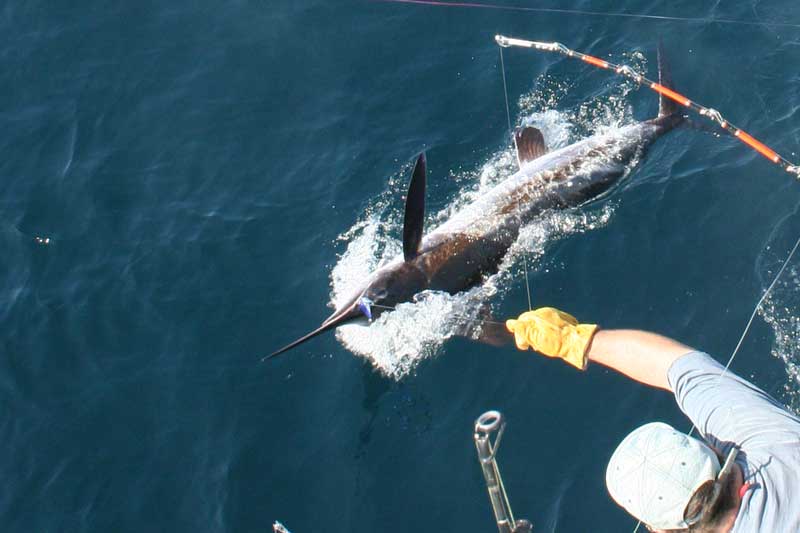
Slack Line – An absence of tension on the fishing line.
Sling-Shot - A method of casting and then using tension on the line and the bend of your rod to re-direct the lure or bait in a different direction.
Soft Plastic – A pliable plastic lure usually used in conjunction with a lead-head jig.
Spincast Reel – A push-button reel which is usually very inexpensive and simple to use, but is not extremely reliable. Most are considered beginner-level.
Spinning Reel – A reel which uses a bail to take up the line and lay it on the reel’s spool, instead of the spool itself revolving. Most people find spinning reels easiest to use, since backlash isn’t an issue.
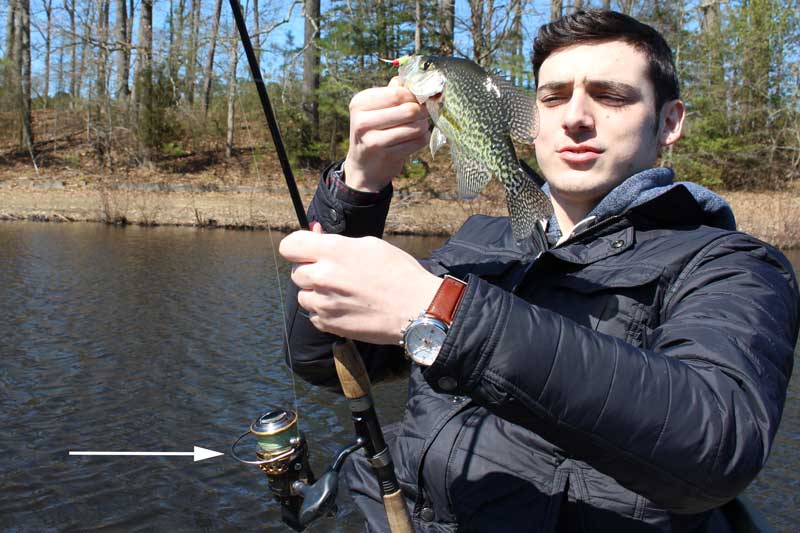
Spinner – A type of lure which has a rotating blade. A “straight shaft” spinner has a blade that rotates around a straight shaft. A Mepps, which was invented over 80 years ago, would be considered the classic example.
Spinnerbait – A lure combining a spinner and a skirted hook (often with an additional body or soft plastic trailer) connected with a small V-shaped wire frame.
Splitshot – A small round lead weight which is split most of the way through. This allows an angler to quickly add weight by placing the line inside the split, and squeezing it tight.
Split Ring – A metal ring which is not sealed but has overlapping ends, and can be opened up to allow an eye to pass over one end and then be rotated until it’s around the entire ring. These are often used to connect hooks to lure eyes.
Spook (Spooked) – A term used to describe when a fish gets too scared to feed, or to strike a bait or lure.
Spoons – Metal lure, sometimes shaped more or less like a spoon, which is used as a fishing lure.
Spreader Bar – A large arm or bar which drags several lines, with small teasers on each, to simulate a school of fish or squid near the water’s surface. A single lure trailing the spreader bar usually has a hook. Spreader bars are most commonly used by offshore anglers targeting tuna, and often an angler will build a spreader bar for tuna fishing.
Star Drag – A drag system found on conventional reels which is adjusted by turning a star-shaped wheel, usually between the reel’s crank and the body. Star drags are inexpensive and effective, but more difficult to adjust with exactness during a fight.
Stickbait – A plug with a long, slender profile, like a stick.
Streamer – A type of lure which has little or no weight, and hook with bucktail, hackle, or another type of filament tied to it. Streamers are often, though not always, used for fly fishing.
Strike – When a fish bites a bait or lure.
Stringer – A thin rope used to hold fish you’ve caught and plan to harvest; some stringers have clips that can be run through the fish’s gillplate and out its mouth, and others are run directly through the fish’s gill plate and tied off.
Stinger (Trailer) Hook – A second hook added to a lure that has a single hook, to decrease the number of missed strikes.
Structure – Any physical underwater feature. Drops and humps in the bottom, sunk trees, wrecks, and even temperature barriers can all be referred to as structure.
Surf Fishing - The practice of fishing in the ocean while standing on the beach, and casting out into the surf.
Surface Lure (Topwater) – A lure worked across the water’s surface.
Swimbait – A lure which appears to swim on its own when pulled steadily through the water.
Swivel (Snap Swivel) – A piece of terminal tackle with an eye at either end, which can rotate in the middle. When it has a metal clip attached to one end it’s known as a snap swivel, which is commonly used to attach a line to a lure or leader.
T
Tackle - All the gear used for fishing.
Tandem Rig – A rig with two lures instead of just one. Some are store-bought, but often anglers enjoy tying their own tandem rigs.
Teaser – Any hookless lure used to attract fish.
Tenkara – A form of fly fishing which consists of just a rod, line attached to the end of the rod, and a fly or lure.
Terminal Tackle – This term is generally applied to any tackle used in addition to the hook but near the end of your line, like a snap swivel, crimp, weight, or ring.
Thermocline – A horizontal temperature barrier between two bodies of water.
Tippett – A leader used for fly fishing.
Treble Hook – Three hooks welded or bent together into a single, triple-pronged unit.
Trolling – The technique of pulling lures and/or baits through the water from a moving boat. Trolling is an extremely effective, popular way to fish. Here are some in-depth how-to articles on trolling:
- Spring Trophy Striper Trolling Spreads
- Kayak Trolling Tips: Tracing the Contours
- How to Catch Tuna Trolling
- Light Tackle Trolling for Trophy Stripers
- Controlling Lure Depth When Trolling from a Kayak
- Offshore Trolling: The Art of the Mixed Spread
- Trolling for Winter Ocean Stripers
- Wa-Wa-Wahoo
- Summer Trolling Tactics for Schoolie Striped Bass
Tube – A soft plastic lure tubular in shape, which is hollow in the middle.
Twister Tail – A soft plastic lure with a sickle-shaped tail that appears to swim as it’s moved through the water. The classic example would be a Mister Twister.
U
Umbrella Rig – A type of rig consisting of several teaser lures and one or more hook-baits, supported and kept untangled by a wire frame.
W
Walking the Dog – The technique of causing a surface plug to swim from left to right, in a zigzag pattern, during the retrieve.
Weedless – Weedless lures have some form of weed-guard that assists them in moving through submerged aquatic vegetation without becoming entangled.
Wet Fly – A fly used for fly fishing which is intended to sink below the water’s surface.
Well there you have it folks, our complete run-down on fishing terminology, lingo, and linguistics. If you hear any terms or angling words you don't understand that we've missed, feel free to send us an email at [email protected] and we'll add it.